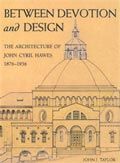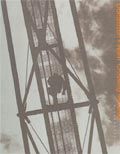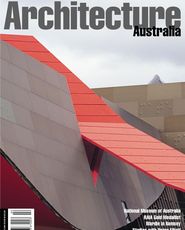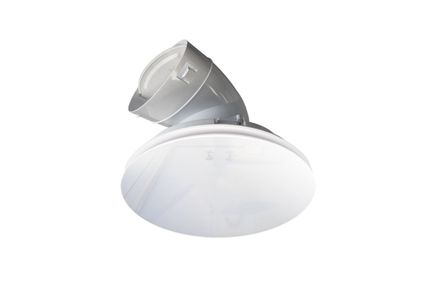Between devotion and design: The architecture of John Cyrill Hawes 1876-1956

John Taylor. UWA Press, $89.95.
John Taylor’s book on the priest-architect ›› John Cyrill Hawes is the most comprehensive ›› in its coverage of his architecture. Hawes’s ›› projects, built and unbuilt, are presented ›› more or less chronologically in what is an ›› extensively researched, documented and ›› illustrated guide to his work. Images are ›› many and varied: photographs, sketches ›› and architectural drawings provide detail ›› and richness while extracts from Hawes’s ›› diary draw informative verbal pictures of ›› building practices and technologies. With a ›› career spanning six decades and even ›› more countries, the research behind this ›› book represents an exhaustive undertaking.
Taylor’s devotion to his self-determined ›› task is no less impressive than Hawes’s to ›› his dual vocations. This is an informative, ›› enjoyable account that makes an ›› important contribution to Australian ›› architectural history.
Although primarily architectural biography, ›› the book also engages implicitly with issues ›› central to twentieth century Australian ›› architectural discourse. Particularly relevant ›› is Hawes’s preference for an architecture of ›› honesty and austerity, stripped of ›› unnecessary embellishment and free of ›› copyism. In fact, “honesty” is a term applied ›› by both Taylor and Geoffrey London (in his ›› foreword) to Hawes’s approach and work.
And honesty, originality and simplicity are key ›› to the conversation appearing in Australia at ›› the turn of the last century and upheld since ›› by numerous architect-critics aligning neo-colonial ›› classicism with Modernist principles.
Hawes clearly shared this same world-view.
But Hawes’s work displays tendencies of ›› eclecticism and plasticity that distance him ›› from the tastes espoused by the Australian ›› orthodoxy, while paradoxically constituting his ›› work as peculiar to this place. The former ›› features prominently in Taylor’s narrative, ›› which recounts the translation into Hawes’s ›› buildings of influences garnered through ›› study and travel. In addition to his arts and ›› crafts training, classical (and colourful)
Mediterranean influences, Eastern traditions ›› and early Modern ideas proliferate. The 1943 ›› sketch for St Patrick’s Cathedral, Ballarat, for ›› example, is Wrightian and certainly ›› Griffinesque in its dramatic interior:
monumentally scaled and exotically themed.
The illustrations reveal the remarkable ›› plasticity of Hawes’s work. In stretching a ›› palette of materials, formal compositions, ›› motifs, and technologies he contrived to ›› accommodate – even construct – a diverse ›› range of social and physical contexts.
Kate Hislop.
Donaldson + Warn: Crossing Midfield

Essay by Duncan Richards and Geoffrey
London. Birkhaüser, $97.
The first international monograph on a ›› contemporary Perth architectural practice, ›› this book is significant not only as a rite of ›› passage for Donaldson+Warn, but also as a ›› world debut for WA’s architecture scene.
Birkhaüser approached D+W in 1997, ›› following the international publication of the ›› Walpole Treetop Walk. UWA and WA’s ›› Department for the Arts, in association with ›› Lotteries, deemed the project worthy of ›› financial support. Most of the design and ›› editing was outsourced to D&W’s office.
Designer Ray Leeves was brought in, and ›› close contact was maintained with Berlin.
Although this remote approach was a first for ›› Birkhaüser, it has enhanced the book’s ›› effectiveness in portraying the practice’s ›› cultural and physical setting.
“Operating on the Edge”, by Duncan ›› Richards and Geoffrey London, is the critical ›› core of the book. It establishes the cultural/ ›› architectural context, outlines the office’s ›› genealogy and explains its key ›› preoccupations: “resistance to becoming a ›› corporate practice”; and the need to ›› “alternate between resistance and response ›› to local particularities”. Sixteen projects are ›› featured, communicating a breadth of ›› approaches – architecturally, constructionally ›› and demographically – from houses in ›› various socio-economic contexts, through ›› public institutional and education ›› architecture, to exhibition system design, and ›› an historically important entry to the long ›› shrouded Perth Foreshore Competition.
The book conveys D+W’s professional ›› capability, but more importantly, the firm’s ›› engagement with – and investment in – WA ›› as a place. The photographs demonstrate ›› this. The architectural setting of casual ›› schoolboys, in their smart suburban Ballajura ›› school, can be contrasted with urban ›› atmosphere of the Lincoln Street duplexes. A ›› “larrikin” formalism is one of D+W’s (anti)
theoretical undercurrents; part of its wit.
Architectural process is generously ›› illustrated: from sketches to line drawings, ›› renderings and models, to site visits. This ›› book will appeal to a broad audience, with its ›› diverse projects, materials and landscapes, ›› and its biography of Perth life. A careful ›› balance has been struck between form and ›› content. The book is worth a closer look.
Gregory Cowan.
Local heroes: Architects of Australia's Sunshine Coast

Peter Hyatt. Craftsman House, $88.
This survey of recent work by Gabriel Poole, ›› John Mainwaring and Lindsay and Kerry ›› Clare is a glamorous work pitched at a broad ›› readership. Some may find the title, the ›› design and the introductory essay a touch ›› overwrought; however, Peter Hyatt’s ›› photography is as rich as his prose, and the ›› architectural subjects are as strong as the ›› typography. Hyatt’s overview strongly ›› emphasises the links between the practices, ›› stressing a shared response to the coastal ›› setting and a common lightness of ›› construction and expression. In the body of ›› the book the firms each present ten projects.
Once the designers are given their own ›› voices, differences in approach become more ›› apparent than the similarities.
The chapter titled “Architecture for the ›› people” highlights Gabriel Poole’s efforts to ›› refine housing systems for a broad market. In ›› the best of these works Poole’s designs ›› exhibit a potent and succinct directness that ›› echoes his no-nonsense anecdotes. By ›› contrast, the John Mainwaring chapter “From ›› Dylan – the music of architecture” suggests ›› both the loose, varied compositional ›› technique of the architect and also his desire ›› to challenge perceptions of the mainstream.
If Poole and Mainwaring’s work is vibrant and ›› spirited, Lindsay and Kerry Clare’s words and ›› work are characterised, in the main, by a ›› clear and calm order enlivened by gentle ›› detail. “The identity of place” seems an ›› insufficient tag for designs of universal ›› appeal like the Hamilton residence.
Hyatt rightly praises the selfless pursuit by ›› all three practices of a built environment ›› worthy of the Sunshine Coast setting. With ›› the movement of the Clares and Mainwaring ›› to Sydney and Brisbane respectively, the local ›› fight is now largely passed to a following ›› generation. Although “heroes” may overstate ›› it, these four architects are certainly ›› esteemed role models for their profession ›› and justly honoured by this publication.
Peter Skinner.















